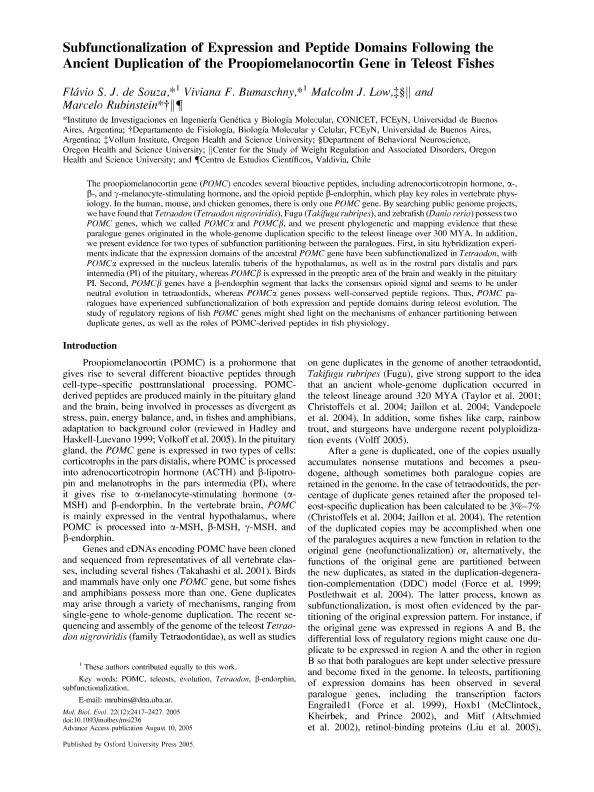Mostrar el registro sencillo del ítem
dc.contributor.author
Silva Junqueira de Souza, Flavio

dc.contributor.author
Bumaschny, Viviana Florencia

dc.contributor.author
Low, Malcolm J.

dc.contributor.author
Rubinstein, Marcelo

dc.date.available
2019-07-18T21:24:13Z
dc.date.issued
2005-12
dc.identifier.citation
Silva Junqueira de Souza, Flavio; Bumaschny, Viviana Florencia; Low, Malcolm J.; Rubinstein, Marcelo; Subfunctionalization of expression and peptide domains following the ancient duplication of the proopiomelanocortin gene in teleost fishes; Oxford University Press; Molecular Biology and Evolution; 22; 12; 12-2005; 2417-2427
dc.identifier.issn
0737-4038
dc.identifier.uri
http://hdl.handle.net/11336/79871
dc.description.abstract
The proopiomelanocortin gene (POMC) encodes several bioactive peptides, including adrenocorticotropin hormone, α-, β-, and γ-melanocyte-stimulating hormone, and the opioid peptide β-endorphin, which play key roles in vertebrate physiology. In the human, mouse, and chicken genomes, there is only one POMC gene. By searching public genome projects, we have found that Tetraodon (Tetraodon nigroviridis), Fugu (Takifugu rubripes), and zebrafish (Danio rerio) possess two POMC genes, which we called POMCα and POMCβ, and we present phylogenetic and mapping evidence that these paralogue genes originated in the whole-genome duplication specific to the teleost lineage over 300 MYA. In addition, we present evidence for two types of subfunction partitioning between the paralogues. First, in situ hybridization experiments indicate that the expression domains of the ancestral POMC gene have been subfunctionalized in Tetraodon, with POMCα expressed in the nucleus lateralis tuberis of the hypothalamus, as well as in the rostral pars distalis and pars intermedia (PI) of the pituitary, whereas POMCβ is expressed in the preoptic area of the brain and weakly in the pituitary PI. Second, POMCβ genes have a β-endorphin segment that lacks the consensus opioid signal and seems to be under neutral evolution in tetraodontids, whereas POMCα genes possess well-conserved peptide regions. Thus, POMC paralogues have experienced subfunctionalization of both expression and peptide domains during teleost evolution. The study of regulatory regions of fish POMC genes might shed light on the mechanisms of enhancer partitioning between duplicate genes, as well as the roles of POMC-derived peptides in fish physiology.
dc.format
application/pdf
dc.language.iso
eng
dc.publisher
Oxford University Press

dc.rights
info:eu-repo/semantics/openAccess
dc.rights.uri
https://creativecommons.org/licenses/by-nc-sa/2.5/ar/
dc.subject
Β-Endorphin
dc.subject
Evolution
dc.subject
Pomc
dc.subject
Subfunctionalization
dc.subject
Teleosts
dc.subject
Tetraodon
dc.subject.classification
Bioquímica y Biología Molecular

dc.subject.classification
Ciencias Biológicas

dc.subject.classification
CIENCIAS NATURALES Y EXACTAS

dc.title
Subfunctionalization of expression and peptide domains following the ancient duplication of the proopiomelanocortin gene in teleost fishes
dc.type
info:eu-repo/semantics/article
dc.type
info:ar-repo/semantics/artículo
dc.type
info:eu-repo/semantics/publishedVersion
dc.date.updated
2019-07-18T13:02:17Z
dc.journal.volume
22
dc.journal.number
12
dc.journal.pagination
2417-2427
dc.journal.pais
Reino Unido

dc.journal.ciudad
Oxford
dc.description.fil
Fil: Silva Junqueira de Souza, Flavio. Consejo Nacional de Investigaciones Científicas y Técnicas. Instituto de Investigaciones en Ingeniería Genética y Biología Molecular "Dr. Héctor N. Torres"; Argentina
dc.description.fil
Fil: Bumaschny, Viviana Florencia. Consejo Nacional de Investigaciones Científicas y Técnicas. Instituto de Investigaciones en Ingeniería Genética y Biología Molecular "Dr. Héctor N. Torres"; Argentina
dc.description.fil
Fil: Low, Malcolm J.. Oregon Health and Science University; Estados Unidos
dc.description.fil
Fil: Rubinstein, Marcelo. Consejo Nacional de Investigaciones Científicas y Técnicas. Instituto de Investigaciones en Ingeniería Genética y Biología Molecular "Dr. Héctor N. Torres"; Argentina. Universidad de Buenos Aires. Facultad de Ciencias Exactas y Naturales. Departamento de Fisiología, Biología Molecular y Celular; Argentina. Oregon Health and Science University; Estados Unidos. Centro de Estudios Cientificos; Chile
dc.journal.title
Molecular Biology and Evolution

dc.relation.alternativeid
info:eu-repo/semantics/altIdentifier/url/https://www.ncbi.nlm.nih.gov/pubmed/16093565
dc.relation.alternativeid
info:eu-repo/semantics/altIdentifier/doi/http://dx.doi.org/10.1093/molbev/msi236
dc.relation.alternativeid
info:eu-repo/semantics/altIdentifier/url/https://academic.oup.com/mbe/article/22/12/2417/1009542
Archivos asociados
